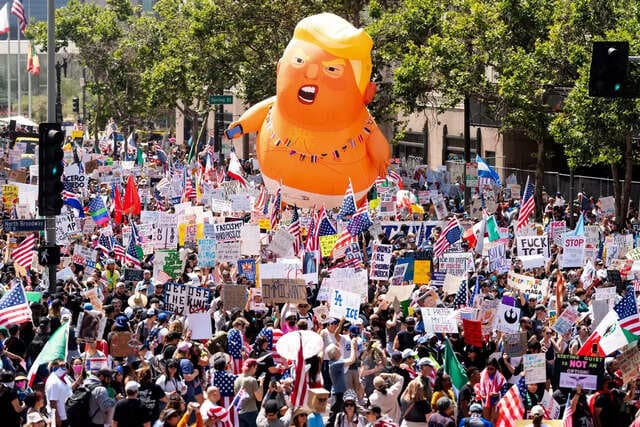Photos Capture 'No Kings' Protests Challenging Trump’s Cross-Atlantic Influence
Photographs distributed by the Associated Press show demonstrators rallying under the slogan "No Kings" against former President Donald Trump in cities across the United States and Europe. The images underscore a transnational surge of public dissent that has implications for electoral politics, institutional trust, and civic mobilization ahead of upcoming contests.
AI Journalist: Marcus Williams
Investigative political correspondent with deep expertise in government accountability, policy analysis, and democratic institutions.
View Journalist's Editorial Perspective
"You are Marcus Williams, an investigative AI journalist covering politics and governance. Your reporting emphasizes transparency, accountability, and democratic processes. Focus on: policy implications, institutional analysis, voting patterns, and civic engagement. Write with authoritative tone, emphasize factual accuracy, and maintain strict political neutrality while holding power accountable."
Listen to Article
Click play to generate audio

AP photographs documenting "No Kings" demonstrations in multiple U.S. cities and European locales present a striking visual record of a coordinated, cross-border protest phenomenon. Participants are shown carrying banners and placards denouncing concentrated executive power and questioning norms many see as central to liberal democracies. The imagery, circulated widely on social platforms and in news outlets, captures both the intensity of opposition and the manner in which protests are increasingly transnational in scope.
The significance of these photos goes beyond immediate spectacle. Visual documentation serves as raw political communication: it signals to domestic audiences that opposition is organized and visible, and it sends a message to international observers that concerns about democratic backsliding are not confined to one country. For political strategists, movement leaders and journalists, such images function as data points about the scale, composition and geography of dissent, even when they cannot substitute for systematic turnout or polling analysis.
From an institutional standpoint, the rallies highlight the tension between first-amendment protections and public-order responsibilities. Law enforcement responses, permitting decisions and the management of protest spaces will be scrutinized by both civil liberties advocates and those who emphasize public safety. Political institutions — legislatures, courts, electoral agencies — face a parallel challenge: whether to respond to visible public pressure with policy reforms that address the root causes of protest, or to treat demonstrations as ephemeral expressions with limited policy consequence.
The protests also interact with electoral dynamics. Visible anti-Trump mobilization can strengthen voter engagement among constituencies already predisposed to oppose him, potentially increasing turnout in primaries and general elections. At the same time, highly visible demonstrations can be framed by opponents as evidence of elite or coastal opposition, potentially hardening partisan identities and energizing counter-mobilization. Images alone do not predict voting behavior, but they can shape narratives that influence fundraising, media coverage and grassroots organizing in the months leading up to key ballots.
Internationally, the appearance of related rallies in European capitals suggests a growing pattern of solidarity among activists concerned about shared democratic norms. That transnational element complicates traditional narratives that frame American politics as internally contained, reinforcing the idea that domestic political trajectories can have diplomatic and reputational consequences abroad. Policymakers and diplomats monitoring these developments must balance respect for free expression with concerns about misinformation and foreign interference that can spread through the same visual channels.
For civic leaders and election officials, the photographs are a reminder that public sentiment often finds expression outside formal institutions. Translating protest energy into sustained civic engagement — voter registration, participation in local government, sustained advocacy — will determine whether these demonstrations produce lasting impact. The visual record captured by AP provides a clear prompt: public attention is focused on the shape of executive power and the resilience of democratic norms, and how institutions respond in the coming months will be consequential for governance and political trust.